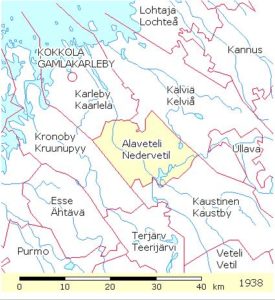By Erik Nygren, from “Nedervetil Kommun Hembygdsbok”.
Translated by June Pelo
 Nedervetil parish courtesy of the Genealogy Society of Finland
Nedervetil parish courtesy of the Genealogy Society of Finland
Österbotten has given Finland most of the greatest poets, but has been short of artists in the usual sense of the word, such as painters, sculptors, or music composers. In consideration of this fact, it is remarkable that Finland’s first sculptor originated from the region of Nedervetil.
Erik Cainberg was born at Kaino, Nedervetil 4 Sep 1771. His father was farmer son-in-law Erik Mattsson Kaino and his mother was Anna Eriksdotter Wirkkala-Kaino.
Early in his childhood it appeared that he was not born to be a farmer. According to tradition he did not participate in the other children’s games and pranks, but killed his time with building mills in the stream. This was the blood of the Riif church builders that flowed through. His mother’s mother was born to the Riif family. Earlier it was thought he had a capability in building skills and before he moved away at age 18, he was a popular master builder in the region.
In 1789 he followed master church builder Jakob Riif to build a church in Umeå (Sweden). This occupation was a means of livelihood for him.
His thoughts were drawn to the arts. During his leisure moments, he sat and “poked about in clay” and seemed to have reached a certain maturity. Of his work, three different medallion portraits of Jakob Riif can be found, and they are considered to be very well done.
Fate did not intend that he become a church builder. During work on a church, an arch fell and Riif was transported to Stockholm under guard and Cainberg had to follow as a witness.
For some reason, perhaps because of inactivity, he went to look in at Fria Fine Arts Academy. His fate was sealed. He became a daily guest in the hall and soon could not keep his fingers from the clay. He asked to do a small design. The great master Sergel with encouraging words gave Cainberg the opportunity to make use of the instruments available in the academy. When Riif decided to return, Cainberg remained at Sergel’s request as a student at the academy in 1792 or 1793. Anders Chydennius returned to Parliament in Stockholm in 1792 and helped his countryman so he could express his inborn talent.
In 1795 he (Cainberg) received first and second prize for modelling from nature. In 1798 he received a recognition that was awarded to young prominent artists. By this time his name had reached Henrik Gabriel Porthan’s ears as shown in a letter to Mathias Calonius. Cainberg continued to work under Sergel’s guidance and received great esteem. He received much praise for a prize work introduced by King Gustav III, the patron of arts and science. Most of his work has, unfortunately, been lost.
In 1802 he was introduced by the president of the academy Fredenheim to King Gustav IV Adolf. At the same time he obtained a scholarship for a six-year stay abroad. He went to Rome and remained there until 1809. Very little is known of his stay there. Literature mentioned a great work of marble with considerable art value that was left in Italy and was found later.
But he idled away his time, probably because the sensitive artist was not taken in charge in the correct way, or did not have sufficient willpower to elbow himself along. He pursued an irregular life and did not live up to expectations of people. His future creations were also erratic. His master could not praise some of his work that was judged below standard. The only known work by Cainberg that is found in his homeland is the relief in the Åbo Academy building, also a medallion in Kajana church. One of his carved marble busts of Porthan was destroyed by fire in Åbo. A portion exists intact in Sweden.
Nature seldom gives all good gifts to one person. Rich artistic talent is often associated with weakness in the character. Had Cainberg attained stability in this regard, his importance in the history of our artists would have been greater. In any event, he was still Finland’s first sculptor. Erik Cainberg died in Åbo 1816. At his death he didn’t own much. The estate inventory consisted of three shirts, 3 1/2 pairs of stockings, one silver snuff box and one wolfskin coat. Debts were 23 rubles. Åbo Academy granted money for burial. This is the main outline of what is known about Cainberg, farmer’s son from Nedervetil, who became an artist. It is only the outer contour; very little is known of his person and his life. But what we know is worth remembering in the parish he came from. We have no wealth of memory and therefore ought to give honor to him in the future.